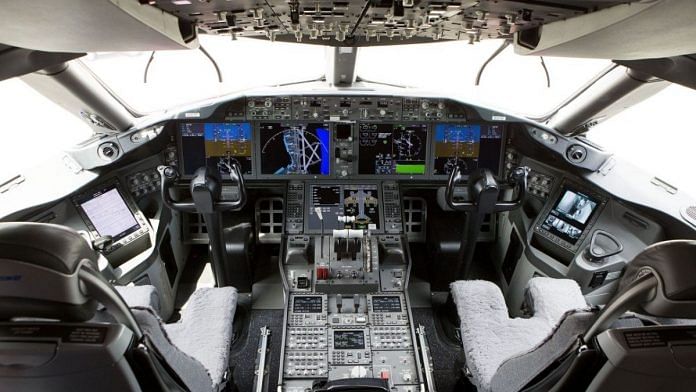I t took just 23 seconds for Qantas Airways Ltd. Flight QF72 to drop 690 feet, throwing passengers into the ceiling midway through its journey from Singapore to Perth.
Within five seconds, the Airbus A330 experienced forces equal to negative 0.8-times gravity switching to 1.56G, which must have felt first like the drop of a roller coaster followed by an acceleration faster than a sportscar. It was a harrowing experience that left more than 100 injured.
When the flight computer went “psycho,” as Captain Kevin Sullivan later described it, he had the second officer by his side and the first officer was already heading back to the flight deck. He needed them. Three minutes later, the aircraft once again pitched down and fell 400 feet in 15 seconds, with the pilots working together to troubleshoot the problem.
Thankfully for the passengers and crew on that October 2008 flight, the cockpit was staffed by two pilots. Cutting flight crews to a single pilot during the bulk of a flight would likely mean a totally different outcome.
That’s nonetheless what Cathay Pacific Airways Ltd. is working with Airbus SE to achieve, Reuters reported last week. The increased automation available on the Airbus A350 would allow a pilot to take a rest break while leaving just one in the cockpit. That would reduce staffing on a long-haul flight from two crews of two pilots each, which typically rotate shifts, to three pilots total, or even fewer.
The push toward so-called single-pilot operation has intensified over the past decade as booming demand for air travel has come up against a chronic shortage of qualified aviators. The world needs to train an additional 550,000 pilots by 2037, according to a 2018 study by the International Civil Aviation Organization, and consultancy Oliver Wyman expects a shortfall of 35,000 as soon as 2025.
That pressure will be particularly intense as financially stricken airlines attempt to rebuild themselves after the Covid-19 pandemic, which has saddled them with more than $220 billion of new debt while operating costs have run about 50% ahead of revenues.
It’s understandable why slimming down the flight crew may be tempting: For the bulk of most flights, journeys through the skies are relatively uneventful. Most of the work that pilots put in is during the take off and landing phases, which also happen to be statistically the most dangerous.
Technology has already allowed airlines to dispense with the radio operator, navigator and flight engineer to create the modern two-person cockpit. Aside from autopilot when cruising, automated landing systems are also now a routine feature used in heavy fog, while the A350 will guide itself to a lower altitude if there’s a loss of cabin pressure. Backing up a single pilot at the controls with a ground operator might be the logical next step.
Statistically, that sounds sensible. But aviation safety isn’t about averages. It needs to be built around the edge cases, the one-off unthinkable scenarios where pilots need to work together to solve a problem. One of the most famous and haunting of these occurred in 1990 when the cockpit window of a British Airways jet blew out at high altitude, partially sucking the pilot out and forcing flight and cabin crew to hold onto the captain while another landed the plane. When Qantas Flight 32 suffered an engine explosion in November 2010, subsequently leaking fuel from a wing, the entire flight deck contributed to solving the problem and arranged a safe landing back in Singapore. Pilot incapacitation is a relatively common occurrence, happening once a month or more in most major aviation markets.
Even when crew aren’t needed to physically save their co-pilots, having a second pair of eyes can be essential. Emergencies happen and need to be resolved quickly — and when something goes wrong, the crew must act fast and communicate effectively in conditions of great uncertainty. It took just over four minutes between first detecting problems on Air France Flight 447 en route to Rio de Janeiro from Paris in June 2009 and the A330 hitting the Atlantic Ocean, with the loss of 228 lives.
Skimping on pilots’ downtime, too, could make it harder for them to bear the cognitive loads necessary to fly safely. In October 2009, a Delta Airlines flight landed on the taxiway in Atlanta, instead of the runway, because the pilots became disoriented. No one was injured, yet investigators later pointed to fatigue as a key contributing factor.
Aviation’s fanatical safety culture has a record to be proud of. Despite more than 37 million commercial departures in 2019 — nearly double the level two decades earlier — the types of in-air accidents that people worry about are mercifully rare. Worldwide, there were just 18 instances of planes either losing control or flying into the ground in the five years through 2019. Where basic rules are followed, even countries synonymous with risky flying such as Indonesia improve fast.
To tempt passengers back into flying metal tubes in the aftermath of a pandemic, though, will require assuring them that those safety standards will continue to be met. Automation isn’t always the best solution to that. It’s been barely more than two years since the latest model of the world’s most popular aircraft, the Boeing Co. 737, was grounded because of problems with its automated control systems that resulted in 346 deaths. As much as a cash-strapped airline industry would love to cut crew costs right now, dropping the pilot would be a reckless move.
Also read: I had to sue Modi govt and Air India to be ‘rescued’ by Vande Bharat Mission



